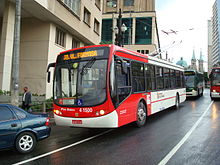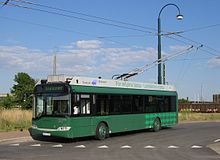

A trolleybus (also known as trolley bus, trolley coach, trackless trolley, trackless tram – in the 1910s and 1920s[1] – or trolley[2][3]) is an electric bus that draws power from dual overhead wires (generally suspended from roadside posts) using spring-loaded trolley poles. Two wires, and two trolley poles, are required to complete the electrical circuit. This differs from a tram or streetcar, which normally uses the track as the return path, needing only one wire and one pole (or pantograph). They are also distinct from other kinds of electric buses, which usually rely on batteries. Power is most commonly supplied as 600-volt direct current, but there are exceptions.
Currently, around 300 trolleybus systems are in operation, in cities and towns in 43 countries.[4] Altogether, more than 800 trolleybus systems have existed, but not more than about 400 concurrently.[5]
- ^ Joyce, J.; King, J. S.; and Newman, A. G. (1986). British Trolleybus Systems, pp. 9, 12. London: Ian Allan Publishing. ISBN 0-7110-1647-X.
- ^ Dunbar, Charles S. (1967). Buses, Trolleys & Trams. Paul Hamlyn Ltd. (UK). Republished 2004 with ISBN 0-7537-0970-8 or 9780753709702.
- ^ "Trolley service begins the next 60 years" (Press release). Vancouver: TransLink. 16 August 2008. Archived from the original on 1 February 2014. Retrieved 6 September 2012.
- ^ Webb, Mary (ed.) (2012). Jane's Urban Transport Systems 2012–2013, pp. "[23]" and "[24]" (in foreword). Coulsdon, Surrey (UK): Jane's Information Group. ISBN 978-0-7106-2994-4.
- ^ Murray, Alan (2000). World Trolleybus Encyclopaedia. Yateley, Hampshire, UK: Trolleybooks. ISBN 0-904235-18-1.